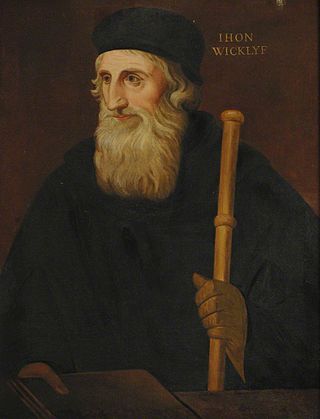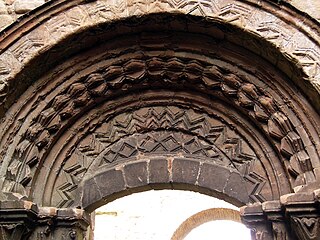Related Research Articles

John Wycliffe was an English scholastic philosopher, theologian, biblical translator, reformer, Catholic priest, and a seminary professor at the University of Oxford. He became an influential dissident within the Catholic priesthood during the 14th century and is considered an important predecessor to Protestantism. Wycliffe questioned the privileged status of the clergy, who had bolstered their powerful role in England, and advocated radical poverty of the clergy.

Lollardy, also known as Lollardism or the Lollard movement, was a proto-Protestant Christian religious movement that was active in England from the mid-14th century until the 16th-century English Reformation. It was initially led by John Wycliffe, a Catholic theologian who was dismissed from the University of Oxford in 1381 for criticism of the Roman Catholic Church. The Lollards' demands were primarily for reform of Western Christianity. They formulated their beliefs in the Twelve Conclusions of the Lollards.
William Tyndale was an English biblical scholar and linguist who became a leading figure in the Protestant Reformation in the years leading up to his execution. He is well known as a translator of most of the Bible into English, and was influenced by the works of prominent Protestant Reformers such as Martin Luther.

In Christian theology, charity is considered one of the seven virtues and was understood by Thomas Aquinas as "the friendship of man for God", which "unites us to God". He holds it as "the most excellent of the virtues". Aquinas further holds that "the habit of charity extends not only to the love of God, but also to the love of our neighbor".

A catechism is a summary or exposition of doctrine and serves as a learning introduction to the Sacraments traditionally used in catechesis, or Christian religious teaching of children and adult converts. Catechisms are doctrinal manuals – often in the form of questions followed by answers to be memorised – a format that has been used in non-religious or secular contexts as well. According to Norman DeWitt, the early Christians appropriated this practice from the Epicureans, a school whose founder Epicurus had instructed to keep summaries of the teachings for easy learning. The term catechumen refers to the designated recipient of the catechetical work or instruction. In the Catholic Church, catechumens are those who are preparing to receive the Sacrament of Baptism. Traditionally, they would be placed separately during Holy Mass from those who had been baptized, and would be dismissed from the liturgical assembly before the Profession of Faith and General Intercessions.
The Philokalia is "a collection of texts written between the 4th and 15th centuries by spiritual masters" of the mystical hesychast tradition of the Eastern Orthodox Church. They were originally written for the guidance and instruction of monks in "the practice of the contemplative life". The collection was compiled in the 18th century by Nicodemus the Hagiorite and Macarius of Corinth based on the codices 472, 605, 476, 628 and 629 from the library of the monastery of Vatopedi, Mount Athos.
Middle English Bible translations (1066-1500) covers the age of Middle English, beginning with the Norman conquest and ending about 1500.

The Cloud of Unknowing is an anonymous work of Christian mysticism written in Middle English in the latter half of the 14th century. The text is a spiritual guide on contemplative prayer. The underlying message of this work suggests that the way to know God is to abandon consideration of God's particular activities and attributes, and be courageous enough to surrender one's mind and ego to the realm of "unknowing", at which point one may begin to glimpse the nature of God.
Ascetical theology is the organized study or presentation of spiritual teachings found in Christian Scripture and the Church Fathers that help the faithful to more perfectly follow Christ and attain to Christian perfection. Christian asceticism is commonly thought to imply self-denial for a spiritual purpose. The term ascetical theology is used primarily in Roman Catholic theology; Eastern Orthodox theology carries its own distinct terms and definitions, and other religious traditions conceive of following and conforming to God and Christ differently from either Orthodoxy or Catholicism.

Wycliffe's Bible or Wycliffite Bibles or Wycliffian Bibles (WYC) are names given for a sequence of Middle English Bible translations believed to have been made under the direction or instigation of English theologian John Wycliffe of the University of Oxford. They are the earliest known literal translations of the entire Bible into English. They appeared over a period from approximately 1382 to 1395.

Wisdom literature is a genre of literature common in the ancient Near East. It consists of statements by sages and the wise that offer teachings about divinity and virtue. Although this genre uses techniques of traditional oral storytelling, it was disseminated in written form.

The Ten Commandments, or the Decalogue, are a set of biblical principles relating to ethics and worship originally from the Jewish tradition that play a fundamental role in Judaism and Christianity. The text of the Ten Commandments appears in three different versions in the Bible: at Exodus 20:2–17, Deuteronomy 5:6–21, and the "Ritual Decalogue" of Exodus 34:11–26.
The Twelve Conclusions of the Lollards is a Middle English religious text containing statements by leaders of the English medieval movement, the Lollards, inspired by teachings of John Wycliffe. The Conclusions were written in 1395. The text was presented to the Parliament of England and nailed to the doors of Westminster Abbey and St Paul's Cathedral as a placard. The manifesto suggests the expanded treatise Thirty-Seven Conclusions for those that wished more in-depth information.
Nicholas Love, also known as Nicholas Luff, was first a Benedictine and then a Carthusian monk in medieval England, and became the first prior of Mount Grace charterhouse in Yorkshire. He was the translator and reviser of a popular devotional treatise which was used by the Church authorities to counter the teaching of John Wycliffe. In his later years he convinced Henry V of England to attempt to reform Benedictine monasticism in England, but died before measures could be taken.

The Mirror of the Blessed Life of Jesus Christ is an adaptation/translation of Pseudo-Bonaventure's Meditations on the Life of Christ into English by Nicholas Love, the Carthusian prior of Mount Grace Priory, written ca. 1400.

Confirmation in the Lutheran Church is a public profession of faith prepared for by long and careful instruction. In English, it may also be referred to as "affirmation of baptism", and is a mature and public reaffirmation of the faith which "marks the completion of the congregation's program of confirmation ministry".
James H. Morey is an American academic. He is a professor of English at Emory University teaching courses in Old and Middle English, including Chaucer.

John Mirk was an Augustinian Canon Regular, active in the late 14th and early 15th centuries in Shropshire. He is noted as the author of widely copied, and later printed, books intended to aid parish priests and other clergy in their work. The most famous of these, his Book of Festivals or Festial was probably the most frequently printed English book before the Reformation.
The Popular Patristics Series is a series of volumes of original English translations of mainly first millennium Christian texts published by St. Vladimir's Seminary Press.

Dives and Pauper is a 15th-century commentary and exposition on the Ten Commandments written in dialogue form. Written in Middle English, while the identity of the author is unknown, the text is speculated to have been authored by a Franciscan friar. Dives and Pauper is structured as a dialogue between two interlocutors, a wealthy layman (Dives) and a spiritual poor man with many similarities to a friar (Pauper). The text engages with orthodox Catholic theology, and further discusses many questions relevant to Wycliffism, an English movement which criticised doctrines and abuses of the Church, which was condemned as heretical by church authorities.
References
- ↑ The Latin version is known as the Ignorantia sacerdotum. For the vernacular version see Thomas Frederick Simmons and Henry Edward Nolloth, ed., The Lay Folks' Catechism..., EETS os 118 (London, 1901). Further see Robert Raymo, "Works of Religious and Philosophical Instruction," in J. Burke Severs and Albert E. Hartung, eds., A Manual of the Writings in Middle English 1050-1500, (New Haven, 1967- ) 7:2270-71.
- ↑ See Valerie M. Lagorio and Michael G. Sargent, "English Mystical Writings," Manual, 9:3116-17, for a list of the various versions.
- ↑ Vernon Manuscript ME version, ed. Carl Horstman, Yorkshire Writers: Richard Rolle of Hampole...and his Followers (London: Swan Sonnenschein, 1895-6), 1:248; Latin versions, ed. Helen P. Forshaw, Edmund of Abingdon: Speculum Religiosorum and Speculum Ecclesie, Auctores Britannici Medii Aevi 3 (London: Oxford University Press, 1973), 60-61.
- ↑ C.A. Martin, "Edinburgh University Library 93: An Annotated Edition of Selected Devotional Treatises," diss. Univ. of Edinburgh, 1978; cited by Raymo, "Works of...Instruction," 2273. For another attempt to classify some groups of Middle English devotional writings, see the introduction to Peter S. Jolliffe, A Check List of Middle English Prose Writings of Spiritual Guidance (Toronto: Pontifical Institute of Mediaeval Studies, 1974).
- ↑ Severs and Hartung, ed., Manual, vol. 7 (New Haven, 1986), pt. XX ("Works of Religious and Philosophical Instruction," by Robert Raymo), p. 2331.
- ↑ Most readily available in its prose version entitled "A Mirror for Laymen and -women": Venetia Nelson, ed., A Myrour to Lewde Men and Wymmen: A Prose Version of the Speculum Vitae, Middle English Texts (Heidelberg: Carl Winter, 1981). See Raymo, "Works of...Instruction," p. 2262 and Valerie M. Lagorio and Michael G. Sargent, "English Mystical Writings," Manual, pt. XXIII, 9:3096-98.
- ↑ See Raymo, "Works of...Instruction," pp. 2340-41.
- ↑ John K. Ingram, ed.,The Earliest English Translation of...the De Imitatio Christi, Early English Text Society Extra Series 63 (London, 1893).
- ↑ Anna C. Paues, A Fourteenth Century English Biblical Version (Cambridge, 1904). On ME Biblical translations, see: Margaret Deanesly, The Lollard Bible and Other Medieval Biblical Versions (Cambridge, 1920); Laurence Muir, "Translations and Paraphrases of the Bible, and Commentaries," Manual, 2:398-403; and Anne Hudson, "Wycliffite Prose," in Middle English Prose: A Critical Guide to Major Authors and Genres, ed. A. S. G. Edwards (New Brunswick: Rutgers University Press, 1984), pp. 252-255.
- ↑ Paues, Biblical Version, pp. 6-7.
- ↑ Adrian James McCarthy, ed., Book to a Mother: An Edition with Commentary, Salzburg Studies in English Literature; Elizabethan & Renaissance Studies 92; Studies in the English Mystics 1 (Salzburg: Institut für Anglistik und Amerikanistik, 1981).
- ↑ Chaucer, Canterbury Tales, "Man of Law's Tale" [Epilogue], II(B1).1168-77.
- ↑ Lillian M. Swinburn, ed., The Lanterne of Light, Early English Text Society 151 (London, 1917), p. 89.
- ↑ Priscilla Heath Barnum, ed., Dives and Pauper, vol. 1 in two parts, Early English Text Society 275 & 280 (London, 1976 & 1980) 1:229-232.
- ↑ Anne Hudson, The Premature Reformation: Wycliffite Texts and Lollard History (Oxford, 1988), pp. 371-74.
- ↑ Anne Hudson, "A Lollard Sect Vocabulary?" in: So meny people longages and tonges: Philological Essays in Scots and mediaeval English presented to Angus McIntosh, ed. Michael Benskin and M. L. Samuels (Edinburgh, 1981), pp. 15-30; rpt. in Lollards and their Books (London: Hambledon Press, 1985), pp. 165-80.
- ↑ Hudson, Premature Reformation, 368-70.
- ↑ Hudson, Premature Reformation, 283.
- ↑ Hudson, Premature Reformation, 285.
- ↑ Hudson, Premature Reformation, 4.
- ↑ Vincent Gillespie, review of The Lyfe of Soule: an Edition with Commentary by Helen M. Moon, Medium Aevum 50.2 (1981): 348-349.
- ↑ A. McIntosh, M.L. Samuels and M. Benskin, with the assistance of Margaret Laing and Keith Williamson, A Linguistic Atlas of Late Mediaeval English (4 vols.; Aberdeen, 1986), LP 8010, vol. 1, p. 105 (Arundel 286); LP 4675, vol. 1, p. 92 (Huntington HM 502).
- ↑ The headnote from this edition represents an earlier version of this Wikipedia article, here submitted by its author and copyright holder.